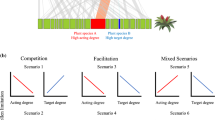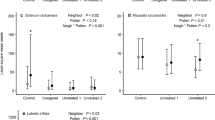Abstract
It is widely recognized that pollinators vary in their effectiveness in pollination mutualisms, due both to differences in flower–pollinator morphological fit as well as pollinator behaviour. However, pollination webs typically treat all interactions as equal, and we contend that this method may provide misleading results. Using empirical and theoretical data, we present the case study of a self-incompatible herb in which the number of flowers visited by a pollinator cannot be used as a surrogate for the total effect of a pollinator on a plant due to differences in per-visit effectiveness at producing seeds. In self-incompatible species, the relationship between interaction frequency and per-interaction effect may become increasingly negative as more flowers per plant are visited due to geitonogamous pollen transfer. We found that pollinators making longer bouts (i.e. visiting more flowers per plant visit) had an overall higher pollination success per bout. However, per-interaction effects tended to decrease as the bout progressed, particularly for pollinators that cause higher pollen deposition. Since the same interaction frequency may result from different combinations of number of bouts (plant visits) and bout length (flowers visited/bout), pollinators making repeatedly shorter bouts may contribute more to plant reproduction for the same number of flowers visited. Consequently, the magnitude of the differences in number of interactions of different insect types may be overridden by the magnitude of the differences in effectiveness as pollinators, even if the same pollinators consistently interact more frequently. We discuss two predictions regarding the validity of using interaction frequency as a surrogate for plant seed production (as a measure of total effect), depending on the degree of self-compatibility, plant size and floral display. We suggest that the role of interaction frequency must be tested for different species, environments, and across wider scales to validate its use as a surrogate for total effect in plant–pollinator networks.





Similar content being viewed by others
References
Aigner P (2001) Optimality modeling and fitness trade-offs: when should plants become pollinator specialists? Oikos 95:177–184
Aizen MA, Harder LD (2007) Expanding the limits of the pollen-limitation concept: effects of pollen quantity and quality. Ecology 88:271–281
Alonso C, Mutikainen P, Herrera CM (2007) Ecological context of breeding system variation: sex, size and pollination in a (predominantly) gynodioecious shrub. Ann Bot 100:1547–1556
Berlow EL, Neutel AM, Cohen JE, De Ruiter PC, Ebenman B, Emmerson M, Fox JW, Jansen VAA, Iwan Jones J, Kokkoris GD, Logofet DO, Mckane AJ, Montoya JM, Petchey O (2004) Interaction strengths in food webs: issues and opportunities. J Ani Ecol 73:585–598
Blüthgen N, Menzel F, Blüthgen N (2006) Measuring specialization in species interaction networks. BMC Ecol 6:9. doi:10.1186/1472-6785-6-9
Chamberlain SA, Schlising RA (2008) Role of honey bees (Hymenoptera: Apidae) in the pollination biology of a California native plant, Triteleia laxa (Asparagales: Themidaceae). Environ Entomol 37:808–816
Colling G, Reckinger C, Matthies D (2004) Effects of pollen quantity and quality on reproduction and offspring vigor in the rare plant Scorzonera humilis (Asteraceae). Am J Bot 91:1774–1782
De Jong TJ, Klinkhamer PGL, Staalduinen MJ (1992) The consequences of pollination biology for selection of mass or extended blooming. Funct Ecol 6:606–615
Dieringer G (1992) Pollinator effectiveness and seed set in populations of Agalinis strictifolia (Scrophulariaceae). Am J Bot 79:1018–1023
Di Pasquale C, Jacobi CM (1998) Dynamics of pollination: a model of insect-mediated pollen transfer in self-incompatible plants. Ecol Model 109:25–34
Fenster CB, Armbruster WS, Wilson P, Dudash MR, Thomson JD (2004) Pollination syndromes and floral specialization. Annu Rev Ecol Evol Syst 35:375–403. doi:10.1146/annurev.ecolsys.34.011802.132347
Goldberg DE, Rajaniemi T, Gurevitch J, Stewart-Oaten A (1999) Empirical approaches to quantifying interaction intensity: competition and facilitation along productivity gradients. Ecology 80:1118–1131
Grindeland JM, Sletvold N, Ims RA (2005) Effects of floral display size and plant density on pollinator visitation rate in a natural population of Digitalis purpurea. Funct Ecol 19:383–390. doi:10.1111/j.1365-2435.2005.00988.x
Harder LD (1990) Pollen removal by bumble bees and its implications for pollen dispersal. Ecology 71:1110–1125
Herrera CM (1987) Components of pollinator quality: comparative analysis of a diverse pollinator assemblage. Oikos 50:79–90
Herrera CM (1989) Pollinator abundance, morphology, and flower visitation rate: analysis of the “quantity” component in a plant–pollinator system. Oecologia 80:241–248
Herrera CM (2005) Plant generalization on pollinators: species property or local phenomenon? Am J Bot 92:13–20
Ivey CT, Martinez P, Wyatt R (2003) Variation in pollinator effectiveness in swamp milkweed Asclepias incarnata (Apocynaceae). Am J Bot 90:214–225
Iwasa Y, De Jong TJ, Klinkhamer PGL (1995) Why pollinators visit only a fraction of the open flowers on a plant: the plant’s point of view. J Evol Biol 8:439–453
Jordano P (1987) Patterns of mutualistic interactions in pollination and seed dispersal: connectance, dependence asymmetries, and coevolution. Am Nat 129:657–677
Jordano P, Schupp EW (2000) Seed disperser effectiveness: the quantity component and patterns of seed rain for Prunus mahaleb. Ecol Monogr 70:591–615
Jordano P, Bascompte J, Olesen JM (2003) Invariant properties in coevolutionary networks of plant–animal interactions. Ecol Lett 6:69–81
Karron JD, Holmquist KG, Flanagan RJ, Mitchel RJ (2009) Pollinator visitation patterns strongly influence among-flower variation in selfing rate. Ann Bot 103:1379–1383. doi:10.1093/aob/mcp030
Kendall DA, Smith BD (1975) The pollinating efficiency of honeybee and bumblebee visits to field bean flowers (Vicia faba L.). J Appl Ecol 12:709–717
Kendall DA, Smith BD (1976) The pollinating efficiency of honeybee and bumblebee visits to flowers of the runner bean bean Phaseolus coccineus. J Appl Ecol 13:749–752
Mayfield MM, Waser NM, Price MV (2001) Exploring the “most effective pollinator principle” with complex flowers: bumblebees and Ipomopsis aggregata. Ann Bot 88:591–596. doi:10.1006/anbo.2001.1500
Memmott J (1999) The structure of a plant–pollinator food web. Ecol Lett 2:276–280
Ness JH, Morris WF, Bronstein JL (2006) Integrating quality and quantity of mutualistic service to contrast ant species protecting Ferocactus wislizeni. Ecology 87:912–921
Ohara M, Higashi S (1994) Effects of inflorescence size on visits from pollinators and seed set of Corydalis ambigua (Papaveraceae). Oecologia 98:25–30
Olesen JM, Jordano P (2002) Geographic patterns in plant–pollinator mutualistic networks. Ecology 83:2416–2424
Paine RT (1988) Food-webs: road maps of interactions or grist for theoretical development? Ecology 69:1648–1654
Paine RT (1992) Food-web analysis through field measurement of per capita interaction strength. Nature 355:73–75
Pellmyr P, Thompson JN (1996) Sources of variation in pollinator contribution within a guild: the effects of plant and pollinator factors. Oecologia 107:595–604
Pinheiro J, Bates D, DebRoy S, Sarkar D, R Development Core Team (2009) nlme: linear and nonlinear mixed effects models (R package version 3.1-96). R Foundation for Statistical Computing, Vienna
Poulin R, Krasnov BR, Shenbrot GI (2008) Interaction frequency across the geographical range as a determinant of host specialisation in generalist fleas. Int J Parasitol 38:989–997. doi:10.1016/j.ijpara.2008.01.001
R Development Core Team (2010) R: a language and environment for statistical computing. R Foundation for Statistical Computing, Vienna. ISBN 3-900051-07-0. http://www.R-project.org
Rey PJ, Herrera CM, Guitián J, Cerdá X, Sánchez-Lafuente AM, Medrano M, Garrido JL (2006) The geographic mosaic in pre-dispersal interactions and selection on Helleborus foetidus (Ranunculaceae). J Evol Biol 19:21–34
Robertson AW, Macnair MR (1995) The effects of floral display size on pollinator service to individual flowers of Myosotis and Mimulus. Oikos 72:106–114
Robertson AW, Ladley JJ, Kelly D (2005) Effectiveness of short-tongued bees as pollinators of apparently ornithophilous New Zealand mistletoes. Austral Ecol 30:298–309
Rodet G, Vaissiere BE, Brevault T, Torre Grossa JP (1998) Status of self-pollen in bee pollination efficiency of white clover (Trifolium repens L.). Oecologia 114:93–99
Rodríguez-Gironés MA, Santamaría L (2010) How foraging behaviour and resource partitioning can drive the evolution of flowers and the structure of pollination networks. Open Ecol J 3:1–11
Sáez L, Crespo MB (2005) A taxonomic revision of the Linaria verticillata group (Antirrhineae, Scrophulariaceae). Bot J Linn Soc 148:229–244
Sánchez-Lafuente AM (2007) Corolla herbivory, pollination success and fruit predation in complex flowers: an experimental study with Linaria lilacina (Scrophulariaceae). Ann Bot 99:355–364. doi:10.1093/aob/mcl267
Schupp EW (1993) Quantity, quality and the effectiveness of seed dispersal by animals. Vegetation 107–108:15–29
Stebbins GL (1970) Adaptive radiation of reproductive characteristics in angiosperms, I: Pollination mechanism. Annu Rev Ecol Syst 1:307–326
Strickler K, Vinson JW (2000) Simulation of the effect of pollinator movement on alfalfa seed set. Environ Entomol 9:907–918
Thompson JN (1994) The coevolutionary process. The University of Chicago Press, London
Thompson JN (2005) The geographic mosaic of coevolution. The University of Chicago Press, London
Thostesen AM, Olesen JM (1996) Pollen removal and deposition by specialist and generalist bumblebees in Aconitum septentrionale. Oikos 77:77–84
Valdés B (1970) Revisión de las especies europeas de Linaria con semillas aladas (Anales de la Universidad Hispalense no. 7). Universidad de Sevilla, Sevilla
Vargas P, Ornosa C, Ortiz-Sanchez FJ, Arroyo J (2010) Is the occluded corolla of Antirrhinum bee-specialized? J Nat His 44:1427–1443
Vázquez DP, Simberloff D (2002) Ecological specialization and susceptibility to disturbance: conjectures and refutations. Am Nat 159:606–623
Vázquez DP, Aizen MA (2004) Asymmetric specialization: a pervasive feature of plant–pollinator interactions. Ecology 85:1251–1257
Vázquez DP, Morris WF, Jordano P (2005) Interaction frequency as a surrogate for the total effect of animal mutualists on plants. Ecol Lett 8:1088–1094. doi:10.1111/j.1461-0248.2005.00810.x
Waser NM, Price MV (1991) Reproductive costs of self pollination in Ipomopsis aggregata: are ovules usurped? Am J Bot 78:1036–1043
Williams CF (2007) Effects of floral display size and biparental inbreeding on outcrossing rates in Delphinium barbeyi (Ranunculaceae). Am J Bot 94:1696–1705
Wilson P (1995) Selection for pollination success and the mechanical fit of Impatiens flowers around bumblebees bodies. Biol J Linn Soc 55:355–383
Wilson P, Thomson JD (1991) Heterogeneity among floral visitors leads to discordance between removal and deposition of pollen. Ecology 72:1503–1507
Acknowledgments
We thank Rebecca E. Irwin, James Cresswell, Diego Vázquez, Jeff Ollerton and two anonymous reviewers for their valuable suggestions to improve earlier versions of the MS. This work was supported by the Spanish Ministerio de Educación y Ciencia (grants BOS2003-00292 to AMSL and CGL2006-02860 to RP) and by Ministerio de Ciencia e Innovación / FEDER (grant CGL2007-63223/BOS) and Junta de Andalucía / FEDER (grant RNM-340) to MARG. All the experiments carried out comply with the current laws of Spain.
Conflict of interest
None.
Author information
Authors and Affiliations
Corresponding author
Additional information
Communicated by Rebecca Irwin.
Rights and permissions
About this article
Cite this article
Sánchez-Lafuente, A.M., Rodríguez-Gironés, M.A. & Parra, R. Interaction frequency and per-interaction effects as predictors of total effects in plant–pollinator mutualisms: a case study with the self-incompatible herb Linaria lilacina . Oecologia 168, 153–165 (2012). https://doi.org/10.1007/s00442-011-2084-z
Received:
Accepted:
Published:
Issue Date:
DOI: https://doi.org/10.1007/s00442-011-2084-z




